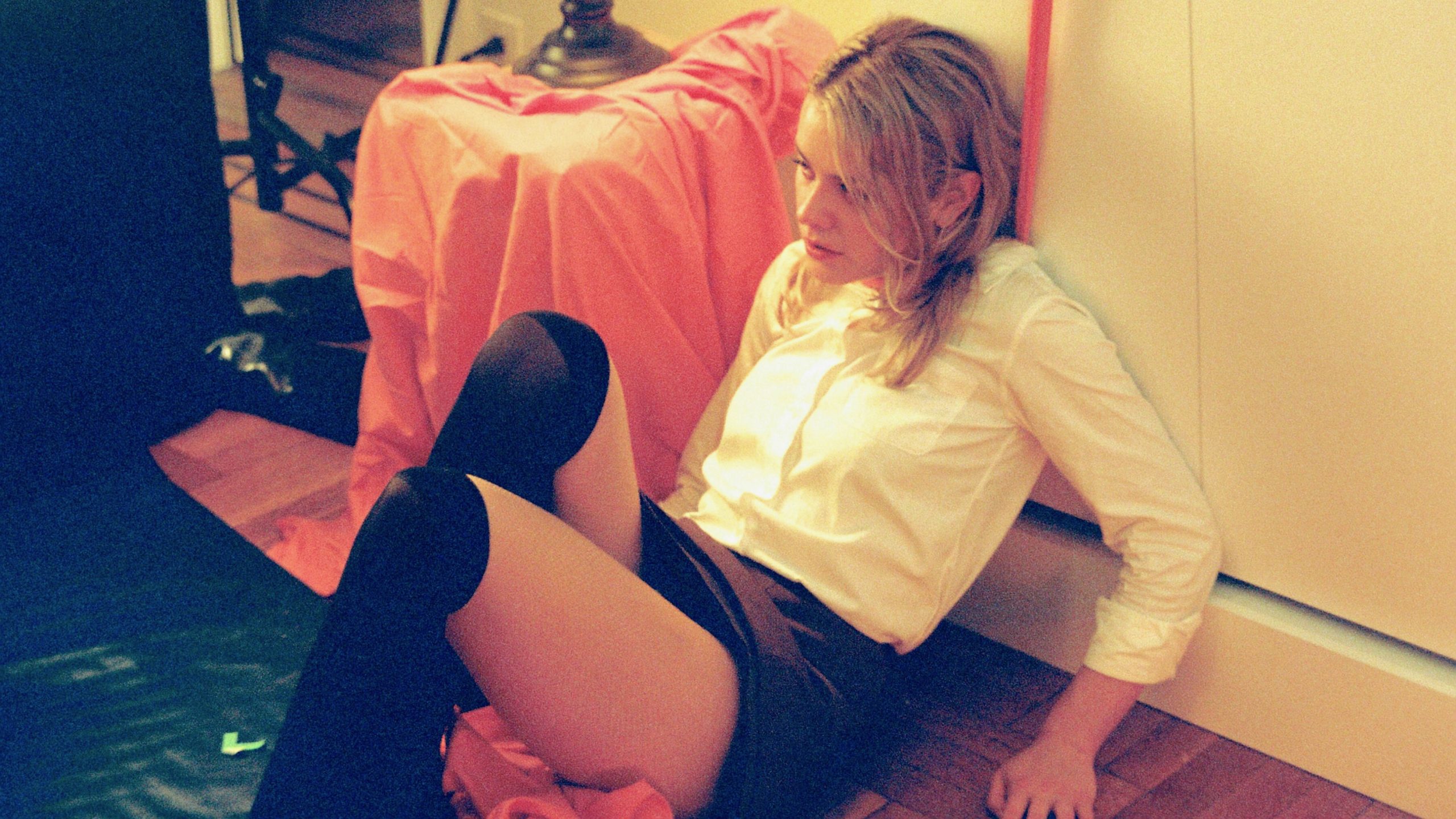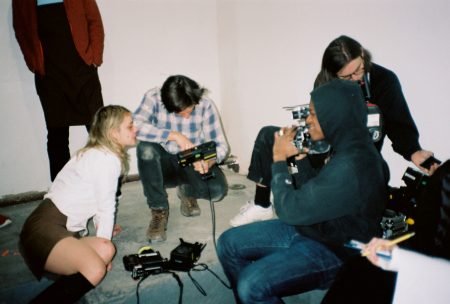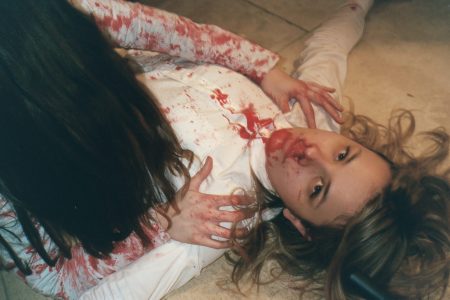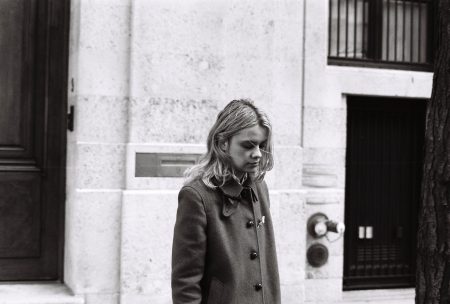 Back to selection
Back to selection
“I Had the Will and the Emotional Momentum… the Movie was Hyper-Topical, Being Made Basically in Real Time”: Dasha Nekrasova on Her Jeffrey Epstein Horror Film, The Scary of Sixty-First
 Dasha Nekrasova on the set of The Scary of Sixty-First (Photo: Utopia)
Dasha Nekrasova on the set of The Scary of Sixty-First (Photo: Utopia) Dasha Nekrasova wanted all the exteriors in her directorial debut to have the ambience of Christmas in New York. First up: leering gargoyles lining the 15-foot front door of Jeffrey Epstein’s Upper East Side apartment building. Clearly, Nekrasova doesn’t share the same merry Christmas cheer as most.
In The Scary of Sixty-First, two roommates move into a semi-furnished apartment that may have been owned by the pedophile billionaire. When an amateur detective hyped up on amphetamines and conspiracies shows up to investigate Epstein’s life and death, the roommates are infected with the haunted truth of their new home. Creating a Repulsion-esque world that fuses reality and fantasy through dysfunctional characters and their bodily fluids, The Scary of Sixty-First has a thrilling, chaotic propulsion with an undercurrent of sardonic humor throughout. But the movie grants you the permission to laugh only as a gateway into the truly horrifying.
Nekrasova is no stranger to sardonic humor. In the last three years co-hosting the podcast Red Scare, she seems to intentionally dangle herself off a cliff of cultural provocation. As an actor — most recently playing a crisis PR consultant on HBO’s Succession — Nekrasova’s controlled sense of masochistic danger is similarly present. There’s an emerging fusion of her psyche as podcaster, actor, writer and director at play, and it’s perhaps through the filmmaking process itself where the synthesis of her point of view is best understood.
Having world premiered in the Encounters section of the 2021 Berlin Film Festival, where it won Best First Feature, The Scary of Sixty-First opens in LA on December 3rd and in New York on December 17th. It’s written by Nekrosova and Madeline Quinn, who star in the film alongside Betsey Brown. Anna Khachiyan who co-hosts “Red Scare” with Nekrasova makes a haunting cameo as Ghislaine Maxwell’s doppelganger.

Filmmaker: In an interview you did with Adam Curtis, he talked about how we’re living in a haunted culture, in the sense of feedback loops and the myths that are created both online and in people’s minds. I wonder if the making of this movie helped resolve something for you?
Nekrasova: Making the film was very cathartic. There were a lot of overlaps with my film and the recent Curtis documentary actually, one being the hauntology of contemporary life, and then also the way that conspiracy theories help people make sense of an emotional truth of the world that’s often in many ways more true than mainstream or status quo narratives. When the Epstein stuff happened I was so obsessed and tormented by it but those efforts felt so futile in a way, so I channeled it into a creative endeavor. I definitely feel catharsis is a good word for it.
Filmmaker: So how much are you still reading and thinking about Epstein? To what extent are you going to follow Ghislaine’s trial?
Nekrasova: I’m going to follow it, but I’m so skeptical. Part of me doesn’t even believe Ghislaine is in jail, like ‘I want to see the body, not some decoy,’ to quote my own film. I’m so at this point mistrustful of media narratives and still feel that sense of helplessness and futility as it pertains to extreme wealth and power. And so it doesn’t feel like the most productive way to channel that energy, and filmmaking felt productive.
Filmmaker: You said in a different interview that you were intending to make a short film when you started writing. Why did you decide to make a feature instead?
Nekrasova: I had never made a film really before and wanted to. Madeline Quinn, my writing partner, and I wanted to collaborate for a while and we were both really obsessed with the Epstein stuff. Making a short film felt manageable, but as we started working on it, it got longer and once it got around to about 40 pages, we decided to expand. There was so much information that needed to be established — it was hard to fit it all into a short film and have it be as effective as we wanted it to be. When it was a short though, the ending was always the ending. I think of short films usually as middles of stories and this was always a story that had an ending.

Filmmaker: Did you have a preconception about being a director, and then did the reality shift for you when you went into production?
Nekrasova: Having worked as an actress on a lot of films, especially low-budget indie films, where not only is the process more collaborative, but there also isn’t usually script supervisor, you’re incredibly mindful of continuity and of how things will cut together. That really prepared me for directing. I felt I had an intuitive understanding for things like blocking — things I had worked on as an actress. I think directing intimidated me for a long time because I’m not really technically proficient as a filmmaker, I guess. But what I was very pleased to learn is that you can get a cinematographer who figures all that stuff out for you!
Elia Kazan wrote a book about directing that I read long before I made Scary, but his musings on directing were very helpful. I am of the belief that everything is the director’s responsibility. Everything that succeeds and fails in a film falls on the director. That’s ultimately what being a director really is — it’s about making a series of decisions. What surprised me most is that it’s a lot of answering a lot of emails.
Filmmaker: Do you think you’d want to simultaneously direct and act again?
Nekrasova: No, definitely not. I’m glad that I did because we were limited in resources and time. It did streamline performing and directing in the sense that I knew what I wanted from myself, but it also split my attention, particularly in the last act where my character is in a state of intense hysteria. And then also having to manage a set was definitely challenging. The days I wasn’t acting I ended up really enjoying a lot. If I had more time it would maybe have been more interesting to cast someone else to play that part. I don’t think I’d act in something I direct again unless it felt super necessary.
Filmmaker: I’ve read some other interviews where you talk about Eyes Wide Shut as an influence. I’m wondering if you can talk about building the aesthetic world of your film — a detail like your character wearing thigh highs sticks out to me, for example. Did you use inspiration images or other films or specific time periods to inspire multiple aesthetic levels?
Nekrasova: There are little aesthetic references to Eyes Wide Shut, i.e. the film taking place during Christmas and some of the lighting. But formally it’s not really influenced by Eyes Wide Shut; it’s more conceptually an influence. The Polanski trilogy was really influential. Possession, obviously with the Betsey Brown sequences. The film gets a lot of comparisons to giallo and that all happened organically. That was never an overt reference I was engaging with. But I think when you’re referencing De Palma, for example, which Hunter and I were doing, you’re indirectly referencing giallo. Little things like my character wearing black gloves, which is a very giallo trope, that all happened very intuitively.
Filmmaker: How did you think about costumes contributing to the psychological and sexual textures of the film?
Nekrasova: We self-styled and did our own hair and makeup (which is why there’s some continuity issues in that department, and why maybe I don’t look as great as I would have had I had professional make-up done). The suit I wore I had made in Thailand, where I was working over the period of scripting. I actually had two suits made from a tailor in Thailand before I had the movie even financed because I sort of just believed I would make it. I often dress in a kind of infantilized way, so creating a character who’s an adult, I was like, ‘what do adults wear? A little business suit?’ Obviously my character’s meant to be sort of like a detective, and I’m really happy with how the wardrobe looks, but I remember some moments putting on my costume where I was like, ‘wow yeah, you really think this is what a grown-up wears!?’
Filmmaker: I want to read you a quote from the 1926 Arthur Schnitzler novella that Eyes Wide Shut is based on. Apparently this is a line that Kubrick underlined in his copy of the book: “As he moves deeper into this strange world he thinks back with affection to the stable world of his everyday realities…he feels the orderly social reality to which he belongs is some kind of monstrous sham.”
Nekrasova: Wow. That’s amazing. I didn’t know Kubrick was drawn to that particular line. You know, Eyes Wide Shut was a little bit panned and misunderstood when it came out because people really thought it was this marital psychosexual drama. It had this little renaissance around the time I was making Scary, partly due to the 20th anniversary and then also Epstein’s death. There were memes going around about Eyes Wide Shut being a documentary. I think Kubrick really understood something about power, and Eyes Wide Shut is really about that beautiful line you read. We are all kind of complicit in this system in its extreme and very intense exploitation.

Filmmaker: How did you go about finding your producer, and what were you looking for with the partnership?
Nekrasova: I really was looking for money. I had no idea. I met Adam Mitchel through Madeline’s boyfriend at the time. He was interested in producing, and he had a relationship with Mark Rappaport, who’s also in the movie, playing “Greg,” the boyfriend. They wanted to make genre movies, but it was a hard sell — a genre movie about Jeffery Epstein. It all happened quickly. They were really great about just pushing to get it done.
Filmmaker: Did you think about waiting to make the film on a bigger budget and scale?
Nekrasova: I never thought about waiting. I felt very motivated to make the film. I felt a real urgency to make it as quickly as possible really. I had the will and the emotional momentum, maybe because the movie was hyper-topical, being made basically in real time. In retrospect, I was probably a little bit manic.
Filmmaker: Don’t you have to be to make your first feature?
Nekrasova: Yeah. I mean I really admire meticulous filmmaking — I’m a massive fan of Stanley Kubrick. But Scary, even with all its flaws, has this energy and momentum I’m really happy with.
Filmmaker: What were you looking for in a cinematographer and how did you end up aligning with Hunter?
Nekrasova: I had worked with Hunter before as an actress — he shot two short films of mine that never really saw the light of day, so I already had a working relationship with him. He had a lot of really good ideas, especially around the motifs of transparency in the film. There’s one shot that’s maybe my favorite in the film. After the girls move into the apartment, there’s a couch that has a plastic tarp over it, and we got a shot of wind blowing through it. Hunter and I really were aligned visually in getting those things. And he’s such a sweet guy, I knew I could trust him to work well with actors. I think the relationship between actors and DPs is sometimes more important than the relationship between directors and DPs because they’re working together in a more intimate way. Particularly all the handheld stuff with Betsey I think is evidence of a really nice synergy between Hunter and the talent.
Filmmaker: Was shooting on film a decision you arrived at together or something you came in knowing you wanted?
Nekrasova: I had never directed anything on film, but I’ve shot little things on film. That was something I wasn’t willing to compromise on. It felt really vital the movie be shot on 16mm, and that really excited Hunter obviously. Cinematographers I think would prefer to always work with film. We were also able to assemble a very talented camera department because there was a lot of enthusiasm for working in the medium.
Filmmaker: The score really elevated the suspense of many sequences. At what stage did you start editing with tracks from the composer?
Nekrasova: Eli [Keszler] agreed to score the film when we started scripting it, and I held him to that and was really excited to work with him. Sophie [Corra], my amazing editor, did a really great temp score that we used as a template. I watched a very early cut of the film with Eli, and we talked through references. A lot of my reference points were psychological and emotional because I don’t understand music all that well. And he then interpreted really well. I’m very interested in affect obviously, so he started composing and refined as the cut was coming together. It was all happening simultaneously, and then he ended up scoring to picture on an almost final cut and doing little revisions. The scene where me and Madeline first take Vyvanse, actually, I knew I wanted to cut to score rather than have Eli score to picture. I’m extremely pleased with the score. I think it’s one of the strongest points of the film, definitely.
Filmmaker: How much were you thinking of the edit as you were filming, and were you surprised by how sequences were coming together in the edit?
Nekrasova: There were definitely sequences we had to find. The dream sequences were not in the script; that was something Sophie and I came to while working together. Sophie is so good at making sense out of chaos. I felt like I could push her to be more experimental and we found a very nice idiom and rapport together. She did a first pass while I was still in New York that I was already really impressed with, and then I went to LA and refined with her. I lived with her, in her now husband’s studio, and we would wake up and work on the cut. It was a really fun five weeks. There are a lot of scenes in the film that are one shot, and because we were working with a finite resource, I had to make the decision not to go in for singles, not to go in for more coverage, but rather to trust that everything will play out in this one frame and this will be the scene. With scenes like that it was really just about trusting it would work, and I think it does.
Filmmaker: What was the most gratifying moment for you? On set? At the premiere? Now, as the movie is opening? Never?
Nekrasova: Finding the film in the edit was very gratifying. Production was a lot of fun, and I was sort of high on my own supply and didn’t really have time to process, so then editing was very satisfying. I didn’t get to go to Berlinale except to receive the First Feature Award. So in general, it’s been a little anticlimactic, yeah. Now that it’s starting to come out, sure. But it’s been so long, I’m a little over it, to be honest. But I’m grateful it’s finding an audience and am happy it’ll exist.
Filmmaker: Did you start writing anything new when you finished post production or did you take a break from writing?
Nekrasova: I have been revising and recently finished a pretty serviceable draft of a script I had been working on four years ago. It’s also genre, but it’s a period piece set in the aftermath of the American Civil War. It was a project I was very passionate about for a long time and when Scary started to get traction and when I got the award, it started to feel more plausible it could get made.
Filmmaker: So, I have to tell you — I met Ghislaine Maxwell about 10 years ago. Someone I was dating ran in some of the same circles, which is obviously a bit of a red-flag in retrospect.
Nekrasova: Totally. Do you think she was trying to recruit you?
Filmmaker: Well, we met at a bar, she talked about her ocean conservation foundation. I expressed interest in interning. She seemed attentive and gave me her card. We had these calls and emails. I don’t know. I looked very young, but obviously not young enough! It just kind of died on the vine.
Nekrasova: It’s interesting, in New York especially, how they’ve brushed up against people’s lives through their long career of human trafficking.
This conversation has been condensed for clarity.
